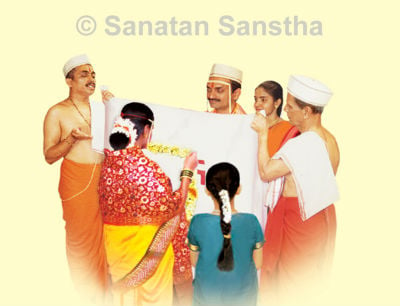
Contents
- 1. The promise of giving the daughter’s hand in marriage (Vagdan/Vanhnishchay)
- 2. Deciding the auspicious time (Muhurtnishchay) and serving a meal to the parents of the bride (Vyahibhojan)
- 3. Rituals performed before the wedding
- 4. Acts to be performed on the day prior to the wedding
- 5. The day of the marriage
- 5.1 Installation of the pot denoting the auspicious time (Muhurtghatikasthapana)
- 5.2 Tying a string of flowers or pearls across the brow (mundavalya)
- 5.3 Departure (Varaprasthan) and arrival (Agaman) of the groom
- 5.4 Donning the sacred thread (Yadnyopavitdharan)
- 5.5 Worship with a mixture of honey and curd (Madhuparka puja)
- 5.6 Worship of Lord Shiva (Har) and His consort Gouri (Gouriharpujan)
- 5.7 Worship of the card denoting the auspicious time (Muhurtpatrikapujan)
1.Gaurihar puja – The promise of giving the daughter’s hand in marriage (Vagdan/Vanhnishchay)
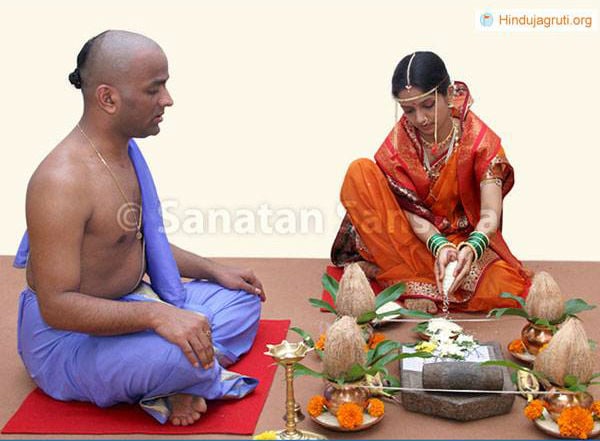
1.1 Origin and meaning
- A. The word Vagdan is derived from two words, vak and dan, meaning speech and donation respectively. Vagdan is promising to offer the daughter to the groom. In worldly terms it means the settlement made by the parents of the boy and the girl about arranging the marriage. In short, it is the resolve expressed by both parents.
- B. Making the commitment of giving the girl’s hand in marriage by the girl’s father, and that of the groom’s father to accept her as a match for his son is called the commitment of arranging the marriage (Vanhnishchay).
1.2 The prevalent custom
It has become customary in the non-Brahman classes to perform the three rituals of Sakshagandha, Sakharpuda and Shalmudi according to the Purans. In reality, these three rituals are incorporated in the single Vedic ritual of Vagdan. Hence, when this Vedic ritual of Vagdan is performed, Sakshagandha, Sakharpuda and Shalmudi need not be performed as prescribed in the Purans.
- A. Sakshagandha: After the promise (Vanhnishchay) to give the daughter’s hand in marriage to the groom is made, sandalwood paste (gandha) and vermilion (kumkum) is applied to the girl to mark the occasion. This is called Sakshagandha.
- B. Sakharpuda: After performing the Vanhnishchay (Sakshagandha), the bride is given a cone filled with sugar (sweetmeats), a sari and some ornament.
- C. Shalmudi: After the Sakshagandha and Sakharpuda, a ritual of presenting the groom a shawl (shal) and a ring (mudi) as a token of confirmation of the engagement is done. This is called Shalmudi.
1.3 The time
Actually, this ritual of promise of giving the daughter’s hand in marriage (Vagdan) should be performed many days before the wedding. This was practised formerly. However, nowadays due to the commencement of new rituals like Sakshagandha, Sakharpuda and Shalmudi, it has become customary to perform this ritual mostly on the day of the wedding or the previous day, at an auspicious time.
1.4 The ritual
First the father (or any guardian in his absence) should send four or eight male relatives to the house of the girl’s father along with married women (suvasinis) dressed in clean attire carrying the materials required for the ritual of Vagdan. This is done at an auspicious moment to the accompaniment of music. Before leaving the house of the groom they should offer obeisance to God. At that time, the groom or his father should pray and chant the mantra which means, ‘O deities ! We have sent our friends by road, to the house of the girl’s father, to ask for the girl’s hand in marriage. May those roads be free of evil elements. May the two deities Aryama and Bhag transport our friends there, safely. May relations build between our family and the family to which they have gone to ask for the girl’s hand in marriage. Also may the married couple lead a happy life’.
The relatives and the father of the bride or in his absence the guardians should welcome the groom’s relatives in the best possible way and offer them the best seats facing the west, as they are the receivers. Opposite them, the bride’s father should offer seats facing the east, to his relatives (as they are giving away the bride). Since they face the east they acquire the energy coming from that direction which is beneficial for the act of giving. Then the groom’s side should ask the girl’s father thrice, for her hand in marriage and the father should reply by saying, ‘I will give’, thrice. Then the groom’s side should pay respects to the girl by offering turmeric, vermilion (kumkum), a sari and a blouse, some ornaments, a packet of sugar, etc. and put some sugar in her mouth. [With relation to physical (adhibhoutik), psychological (adhidaivik) and spiritual (adhyatmik) dimensions it is a practice to ask thrice and a reply in the affirmative is given.]
1.5 The prayer to Indrayani
The prayer to be made by the bride and the groom – ‘By Your grace may my wedding take place without any obstacles. May I be able to acquire good fortune, health and a good son’.
2. Gaurihar Puja – Deciding the auspicious time (Muhurtnishchay) and serving a meal to the parents of the bride (Vyahibhojan)
These are just popular customs.
- A. Deciding the auspicious time (Muhurtnishchay): After approval of the bride, discussion about exchange of gifts takes place. Then the day of the marriage and the auspicious time (muhurt) for the same is fixed in consultation with an astrologer.
- B. Serving a meal to the parents of the bride (Vyahibhojan): The parents of the bride are forbidden from having a meal at their daughter’s (in-laws) place until she gives birth to a son. Hence the parents of the groom invite them over for a meal before the wedding and dine with them. This is called Vyahibhojan. It is customary to offer gifts to the bride’s parents on this occasion.
- C. Offering consecrated rice (akshat): The host and the hostess first and foremost invite the family deity, followed by Lord Ganapati, the female deity (devi) and the deity of the village (gramadevata) to solicit their presence on auspicious occasions such as marriage, thread ceremony (Munja), etc. This invitation to which vermilion (kumkum) is applied is placed before the deities along with consecrated unbroken rice grains (akshata) tinged with vermilion, betel leaves, a coconut and a ladu (sweetmeat) of sesame seeds (til). At this time a prayer is made so that the auspicious function takes place smoothly without any obstacles. Then the host couple sets out to invite the others. In Maharashtra in India such invitations are given along with unbroken rice tinged with vermilion (kumkumakshata). It is known as offering akshat.
3. Gaurihar Puja – Rituals performed before the wedding
3.1 The ritual of Ganayag
The wedding ceremonies start four days before the wedding at the groom’s place and three days before it at the bride’s place. On the first day excluding inauspicious stellar constellations like Bhadra, etc. at an auspicious time, mostly at night the ritual of Ganayag or Jevnar is performed. Five married householders (gruhastas) are chosen for it and they are made to worship the family deity using oil, turmeric, vermilion (kumkum), flowers, etc.
3.2 The ritual of application of oil and turmeric paste (Tailharidraropan vidhi)
The ritual of bathing the one on whom the sanskar (rite) of marriage is to be performed after an application of oil and turmeric paste is called Tailharidraropan vidhi. The turmeric is put in a mortar and pounded by five married women (suvasinis). The ability to absorb the energy generated by religious rituals is increased by oil and turmeric. The pure spiritual particles in the environment too are attracted by turmeric and remain in the body for a longer duration, due to the oil. The same principle is applied in the offering of oil to Maruti, and turmeric and vermilion to deities.
A popular custom: The bride and her parents are made to sit on a wooden seat (pat) on which wheat grains are spread. Then oil and turmeric is applied to them by married women and they are given a ritualistic bath (mangal snan). The turmeric which is left-over after applying to the bride is sent to the groom. It is called ‘ushti halad’ meaning the left-over turmeric. This turmeric is later applied to the groom and he too is given a ritualistic bath.
3.3 The ritual of Gadagner
On the second day the ritual of Gadagner (or Gadagnhan) is performed. In this, five married women (suvasinis) and their husbands apply oil, perfume, etc. and bathe along with the bride at the bride’s place and along with the groom at the groom’s place.
4. Gaurihar Puja – Acts to be performed on the day prior to the wedding
- A. Definition: If sanskars (rites) like Jatakarma (the rite at birth), etc. have not been performed at the right time then on the day prior to the wedding one has to perform acts such as penance for omission of sanskars, the resolve for marriage (Vivahasankalpa), worship of Lord Ganesh, Punyahavachan, worship of the Matruka deities, Nandishraddha, a sacrificial fire for the planets (grahayadnya), installation of the deity of the pandal (mandapdevatapratishtha), installation of the family deity (kuladevata) and worship of the deity of oil and turmeric (tailharidradevata).
- B. Preparation: On the day before the wedding the father of the bride and the father of the groom should apply oil and bathe (abhyangasnan), so also should the bride and groom, in their respective homes. Then wearing good clothing and draping the shoulders with a garment they should sit facing the east. The wife should sit to the right of the husband and the one on whom the sanskar is to be performed, that is the bride or the groom, on her right side.
4.1 The resolve (sankalpa) for the marriage of the son and daughter
- A. The resolve for the son’s marriage: ‘I am performing this rite of marriage (Vivaha sanskar) of my son named ….. to acquire the grace of The Lord and to acquire the ability to generate progeny capable of liberating him from the debts to the deities and ancestors, according to Righteousness (Dharma).’
- B. The resolve for the daughter’s marriage: ‘I am performing this act of the rite of marriage of this daughter of mine so as to acquire the grace of The Lord by following Righteousness along with her husband, generating progeny, accepting the fire worshipped in the house (gruhyagni) and attaining the right to follow the path of Righteousness.’
- C. The resolve to be made by both the parties, that is the bride’s and the groom’s: ‘I will perform the rite of marriage of my son named …. or daughter named …., tomorrow. I am performing the worship of Lord Ganapati, Svastivachan, worship of the Matruka deities, Nandishraddha and a sacrificial fire for the planets (grahayadnya) to obtain their favourability, installation of the deity of the pandal (mandapdevata) and of the family deity (kuladevata). I am also worshipping the deity of oil and turmeric.’
4.2 Installation of the deity of the pandal/ installation of deities (mandapdevatapratishtha / devak basvine)
‘It is customary to establish the deity of the pandal and Lord Ganapati, the vanquisher of obstacles, at the commencement of the sanskars (rites) of marriage, thread ceremony, etc. so as to carry them successfully to completion. This itself is known as installation of the deities (devak). For this, sacred grass (durva), leaves of trees such as shami, etc. are rolled in leaves of the mango tree and tied with new cotton thread. Six such bundles are made. The fifth bundle among these represents the pestle (musal). A stick of sacrificial firewood (samidh) is included in this bundle. A blade of sacred grass (darbha) is put in one of the bundles to symbolize a weapon. All these are known as branches (shakha). Then the branches are affixed to a new sifting pan (sup) in the following manner – four on one side, the bundle containing the pestle and the stick of sacrificial firewood is placed to their north and the bundle with the weapon of sacred grass to its north. Then consecrated rice (akshata), turmeric and betelnuts are put into an earthen pot which is painted white. The mouth of the pot is closed with an earthen lid and a cotton thread is wound around it. The pot is also placed in the sifting pan. It is called the pot warding off obstacles (avighnakalash). A coconut draped with cotton thread, symbolising the family deity is placed beside it. Commencing from south to north the deities Nandini, Nalini, Maitra, Uma, Pashuvardhini and Shastragarbha Bhagvati in that order are invoked in the six bundles and Lord Ganapati the vanquisher of obstacles is invoked in the pot. The five deities are then established on the pillars in the four corners of the pandal and the central pillar and are ritualistically worshipped. After this the host lifts the pot warding off obstacles and places it in his wife’s hand while he holds the sifting pan. Then the host couple installs the pot and the sifting pan on three heaps of rice in a clean, decorated north-east corner of the house or near the temple in the house. Various mantras are to be chanted when all these rituals are being performed. This ritual is known as installation of the deity of the pandal (mandapdevatapratishtha).
After the completion of the above ritual the relatives and friends of the host offer presents like clothes, etc. to the host couple. The Marathas and people belonging to some other classes perform the ritual two days before the wedding. The hosts of both sides go to the respective trees where their family deity (devak) is situated and perform ritualistic worship (puja). A small branch of that tree is cut and brought home in a new sifting pan. Later that sifting pan is placed in the temple in the house and the betelnuts representing the various deities of the household are arranged in it and are all ritualistically worshipped. Simultaneously the washerwoman worships the grinding stone. On the day of the marriage the groom is asked to sit on the grinding stone. Vermilion (kumkum) is applied to his forehead and unbroken rice (akshata) over it. This is known as the ceremony of “shes dharne”.’(1) This ritual is also known as the ritual of Devakundi or installation of the deities (devak), that is the ritual of establishing the divine pot (Kalashsthapanprayog).
5. Gaurihar Puja – The day of the marriage
The rites prior to marriage
5.1 Installation of the pot denoting the auspicious time (Muhurtghatikasthapana)
- A. The resolve (sankalpa): ‘I am installing the ghatikayantra to know the auspicious moment for my daughter’s marriage rite (Vivaha sanskar) scheduled for today.’
- B. The ritual: A copper vessel should be placed on a heap of rice or any other food grain. Then chanting the mantra ‘Imam me (??? ??)’ water should be poured into it and the ghatikayantra should be placed in it. One chants a mantra with the following meaning ‘O yantra (device) you are the chief among the yantras created by Prajapati (Lord Brahma). Hence become the instrument of time in uniting the bride and the groom’.
5.2 Tying a string of flowers or pearls across the brow (mundavalya)
On the day of the wedding after completing his ritualistic actions (nityakarma) the groom should have lunch with his friends. At that time he should wear new attire and have the ‘mundavalya’ tied across his brow. It is made by stringing together flowers or beads. This headgear is tied across the brow so that the ends overhang both the cheeks. In some non-Brahman communities there is a custom of tying a headgear made from paper (bashing).
5.3 Departure (Varaprasthan) and arrival (Agaman) of the groom
These are popular customs.
- A. Refreshments (rukhvat): ‘Before the departure of the groom (varaprasthan) the members of the bride’s family go to the place where the groom’s side has put up, amidst pomp and fanfare. A decorated vehicle and refreshments (rukhvat) meant for the groom also accompany the procession. After serving refreshments to the groom he is requested to come to the bride’s house. This ritual is also called “mul jane – going to fetch the bride from her home”.’(2)
- B. Departure of the groom to the bride’s house (Varaprasthan): ‘The groom’s leaving for the bride’s house to wed her amidst playing of auspicious musical instruments is called the departure of the groom to the bride’s house (Varaprasthan). At that time the groom should pay obeisance to the elders and proceed to the bride’s house along with his friends, in the vehicle. The Brahmans should accompany the groom chanting the “Kanikradajjanusham” sukta. Married women (suvasinis) should also accompany the groom.The servant walks behind the groom holding a plate of sweetmeats (halva). The groom’s sister walks with the groom holding a metal pot containing water (kara), a coconut and a twig of mango leaves. She is known as the “karavli”. Should one pass a territory of a deity or encounter cross roads, a coconut is moved around the groom’s head and broken. As the groom reaches the decorated lintel (toran) of the pandal the maid servant pours a pot of water on his feet. Rice and curd mixed together is rotated around the groom’s head by a married woman or the bride’s mother. This is followed by moving lit lamps around his head (oukshan). Then the bride’s father comes forward, hands a coconut to the groom and leads him into the pandal (mandap).’(3)
- C. The ritual of worship while crossing the border (Simantapujan):1. Definition: The practice of honouring the groom at the border after he leaves his village (or if the proposal is from the same village, when he leaves his house) and enters the bride’s village by the bride’s relatives offering him clothes, etc. is known as the ritual of worship while crossing the border (Simantapujan).
2. Welcoming the groom and honouring the elder son-in-law: ‘In this ritual of worship (puja) the bride’s father washes the feet of the groom and offers him clothes and ornaments. At the same time he also offers betelnuts and betel leaves to all other members of the groom’s side. Before the ban on the dowry system by the law, the bride’s father would give the dowry to the groom’s father. The groom’s father would receive the dowry fearing that it may not be given after the marriage. According to the scriptures the offering to the groom (Varadakshina) is given after the giving away of the bride (Kanyadan). At the time of Simantapujan the bride’s father has to offer clothes and honour the elder son-in-law and daughter. This is referred to as the honouring of the elder son-in-law.’(4)
3. The place: This ritual rather than being Vedic is worldly. As its name suggests it should be performed at the village border. However, at present it has become customary to perform it either at the place where the groom stays after his arrival at the bride’s village, in the temple of some deity like Maruti or any other convenient place.
5.4 Donning the sacred thread (Yadnyopavitdharan)
Before marriage the groom wears one sacred thread (yadnyopavit). After the tying of the headgear (mundavalya) to the groom the bride’s father gives him another sacred thread which is worn along with the previous one. After marriage one has to wear two sacred threads.
5.5 Worship with a mixture of honey and curd (Madhuparka puja)
- A. Definition: The mixture of honey and curd is called madhuparka. This mixture has a greater ability to absorb pleasant frequencies than either honey or curd alone. [Further details are given in‘Science of Spirituality: Chapter 7 – Path of Devotion (Bhaktiyoga)’.] Some add sugar cubes (khadisakhar), clarified butter (ghee) and water to the above mixture. If curd and honey are not available then milk is used instead of curd and jaggery instead of honey.
- B. The resolve (sankalpa): ‘I am worshipping the groom who has come to my place to accept my daughter, with madhuparka as a part of giving away the daughter (Kanyadan)’. The bride’s mother should pour water and the bride’s father should first wash the groom’s right, then left and then both the feet and wipe them with a dry towel.
- C. Sprinkling of the mixture of honey and curd (Madhuparkaprokshan): Using the thumb and ring finger the groom should sprinkle the madhuparka in various directions intended for various deities and then partake of it. The deities get appeased with this act and prevent obstacles posed by distressing energies at the marriage ceremony.
5.6 Worship of Lord Shiva (Har) and His consort Gauri (Gaurihar puja)
This is a popular ritual.
- A. Definition: Worship of Gauri and Har means the worship of the deities Parvati and Shiva.
- B. The ritual: On the wedding day the bride should be given a ritualistic bath (mangalsnan) and new clothes to wear. Then on the grinding stone and muller used in the house (or two other stones) pictures of Gouri and Har should be drawn with turmeric. New cotton thread should be wound around the grinding stone. Then four pots should be placed on its four sides and it should be worshipped with the resolve of prolonging married life, etc. The reasons behind worshipping Gouri and Har thus are as follows:1. Just as the relationship of the grinding stone and the muller with one another is binding and solid so should that of the bride and groom be.
2. The energy generated in the grinding stone should enter their system through food and increase their sattvik (sattva predominant) nature.
- C. The resolve (sankalpa): ‘I am worshipping Gouri and Har so that I may acquire eternal married life, good progeny and plentiful food, wealth, etc.
Until the time of departure to the pandal (mandap) for the wedding, the bride keeps offering rice to Gouri and Har. After this worship when the bride is taken for the ritual of holding the wedding curtain (Antahapatdharan vidhi) the bride’s mother takes over the worship of Gouri and Har until the wedding ceremony is complete so that the bride has a happy life. Consequently she does not see the bride and groom garlanding one another. This rule is followed so that the mother does not feel unhappy thinking “my daughter now belongs to someone else” and mar the spirit of the happy occasion. As men are less emotional than women this rule does not apply to the bride’s father. In some communities the groom’s mother too does not listen to the chanting of the eight auspicious verses (mangalashtakas) thinking that now she does not have a right to her son as before.
5.7 Worship of the card denoting the auspicious time (Muhurtpatrikapujan)
Before the wedding ceremony starts, the card written by the astrologer denoting the auspicious time should be worshipped. This is called worship of the card denoting the auspicious time (Muhurtpatrikapujan).
Reference:
‘Sixteen Sanskars and some other rituals’, published by Sanatan Sanstha.
Bharatiya Sanskrutikosh. Publishers: Pandit Mahadevshastri Joshi, Secretary, Bharatiya Sanskrutikosh Mandal, 410 Shanivar Peth, Pune 411 030.
Vol. 3 to 10: First edition Vol. 1 and 2: Second edition
1. Vol.4, Pg. 423, 424
2. Vol 8, Pg. 730
3. Vol 8, Pg 727, 730
4. Vol 8, Pg 727

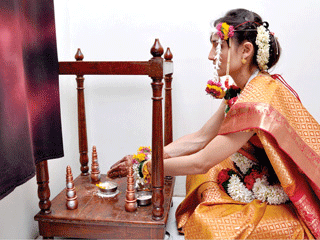
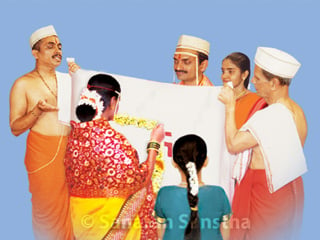 Spiritualize every act performed in a Hindu Marriage ceremony !
Spiritualize every act performed in a Hindu Marriage ceremony !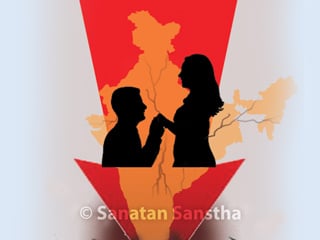 Danger of collapse of the family system due to the resulting immorality !
Danger of collapse of the family system due to the resulting immorality !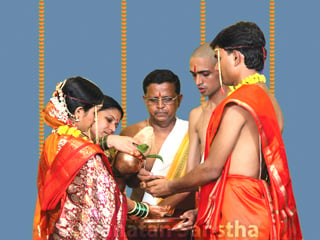 Kanyadan
Kanyadan